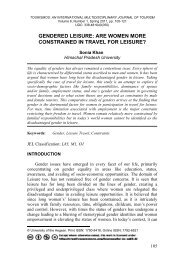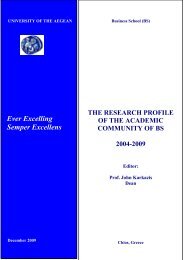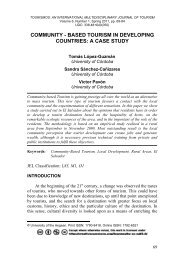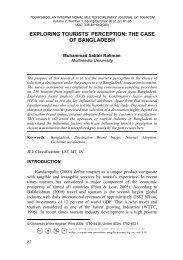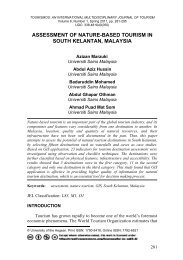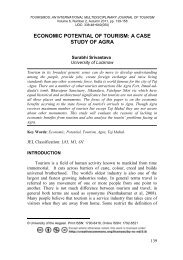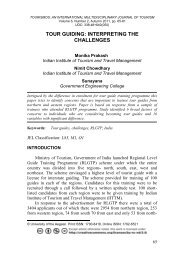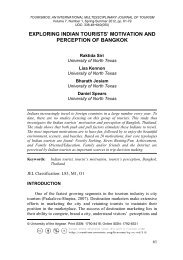TOURISMOS is an international, multi-disciplinary, refereed (peer ...
TOURISMOS is an international, multi-disciplinary, refereed (peer ...
TOURISMOS is an international, multi-disciplinary, refereed (peer ...
You also want an ePaper? Increase the reach of your titles
YUMPU automatically turns print PDFs into web optimized ePapers that Google loves.
<strong>TOURISMOS</strong>: AN INTERNATIONAL MULTIDISCIPLINARY JOURNAL OF TOURISM<br />
Volume 6, Number 1, Spring 2011, pp. 213-220<br />
UDC: 338.48+640(050)<br />
• subjective image associated to Turin (including familiarity with<br />
attractions such as Mole Antonelli<strong>an</strong>a, Egypti<strong>an</strong> Museum,<br />
Museum of Cinema, etc.);<br />
• suggestions for improvement.<br />
Most respondents were academics (55% of the sample cons<strong>is</strong>ted of<br />
professors, research ass<strong>is</strong>t<strong>an</strong>ts, <strong>an</strong>d Ph.D. students), followed by people<br />
operating in the medical sector (17%). The rest cons<strong>is</strong>ts of practitioners,<br />
marketing people, publ<strong>is</strong>hers, etc. The same questionnaire was<br />
admin<strong>is</strong>tered to org<strong>an</strong>izers, but clearly different questionnaires should be<br />
dev<strong>is</strong>ed.<br />
About 50% percent of the sample cons<strong>is</strong>ts of Itali<strong>an</strong> particip<strong>an</strong>ts. As<br />
expected, most come from Northern Italy, but the percentage from<br />
Southern <strong>an</strong>d Central Italy <strong>is</strong> quite signific<strong>an</strong>t, which shows the potential<br />
impact on domestic tour<strong>is</strong>m. Foreign particip<strong>an</strong>ts were mainly Europe<strong>an</strong><br />
(76%); North America (11%) <strong>an</strong>d Asia (5%) follow next. It should be<br />
remarked that Turkey has been considered as a part of Europe rather th<strong>an</strong><br />
Asia, <strong>an</strong>d th<strong>is</strong> has <strong>an</strong> impact as most Europe<strong>an</strong> v<strong>is</strong>itors came from UK <strong>an</strong>d<br />
Turkey, followed by Germ<strong>an</strong>y <strong>an</strong>d Fr<strong>an</strong>ce. Arguably, the unexpected role<br />
played by Turkey <strong>is</strong> due to signific<strong>an</strong>t investment by Turk<strong>is</strong>h government<br />
on University, but it could also be the effect of a biased sample.<br />
Data on expenditure were also collected, suggesting that 37% of the<br />
budget <strong>is</strong> spent for the conference fee <strong>an</strong>d 26% for the accommodation;<br />
14% <strong>is</strong> spent for shopping. Little (3%) <strong>is</strong> spent for recreational activities;<br />
here the l<strong>an</strong>guage barrier may play a role, as Itali<strong>an</strong> <strong>is</strong> certainly not a<br />
widely spoken l<strong>an</strong>guage, but th<strong>is</strong> may suggest the opportunity of better<br />
leveraging the rich set of available museums. Nevertheless, such data<br />
must be taken with the utmost care; for inst<strong>an</strong>ce, a museum v<strong>is</strong>it could be<br />
part of conference program, <strong>an</strong>d therefore included in the conference fee.<br />
Indeed <strong>an</strong>alyzing expenditure <strong>is</strong> a very difficult <strong>is</strong>sue that c<strong>an</strong>not be<br />
addressed by one questionnaire, <strong>an</strong>d event org<strong>an</strong>izers must be involved.<br />
MICE expenditure patterns <strong>an</strong>d their impact on regional economic<br />
development are carefully <strong>an</strong>alyzed, e.g., in (Dwyer et al., 2001), where<br />
the authors point out that only expenditure from outside <strong>is</strong> relev<strong>an</strong>t (th<strong>is</strong><br />
should include sponsors). However, if a particip<strong>an</strong>t pays for petrol at a<br />
filling station, little <strong>is</strong> really injected into the region. We should also<br />
consider money spent by people living inside the region, that would flow<br />
outside if events were held in <strong>an</strong>other city. Whether th<strong>is</strong> <strong>is</strong> signific<strong>an</strong>t or<br />
not depends on how m<strong>an</strong>y particip<strong>an</strong>ts come from the same region; in our<br />
sample, they are not too m<strong>an</strong>y, but the question deserves further <strong>an</strong>alys<strong>is</strong>,<br />
given the industrial background of our region.<br />
217



